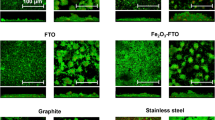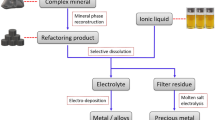Abstract
The main studies on the corrosion of metals induced by microorganisms are directed only to the surface of the metal, without considering the presence of welds between these surfaces. For this reason, we evaluated the difference of microbial community grown in carbon steel coupons, and two different types of welds, E7018 and Tungsten electrodes, exposed under simulated microcosm. After 30 days, they were recovered, the biofilms scraped and the microbial communities analyzed by 16S rRNA gene sequencing. The results showed that there was a differentiated distribution among the three samples collected. Proteobacteria phylum composed most of the species described in all samples. At the class level, Gammaproteobacteria was the most detected, followed by Alphaproteobacteria and Flavobacteriia. The most prevalent order was Alteromonadales, which was present in Weld2, followed by Rhodobacteriales, which was more prevalent in Fe1020 and Weld1. The orders Cytophagales, Sphingomonadales, and Burkholderiales were described in higher number in Fe1020, whereas Oceanospirillales, Thiotrichales, Flavobacteriales, Rhodospirillales, and Kordiimonadales were higher in samples Weld1 and Weld2. The analyses between the three evaluated conditions show the presences of bacterial groups preferred by different types of metal, suggesting that approaches in the control of biocorrosion should take into account the chemical composition of the metal.







Similar content being viewed by others
References
An D, Dong X, An A, Park HS, Strous M, Voordouw G (2016) Metagenomic analysis indicates Epsilonproteobacteria as a potential cause of microbial corrosion in pipelines injected with bisulfite. Front Microbiol 7:28. https://doi.org/10.3389/fmicb.2016.00028
Blackwood D (2018) An electrochemical perspective microbiologically influenced corrosion. Corros Mater Degrad 1:59–76. https://doi.org/10.3390/cmd1010005
Bonifay V, Wawrik B, Sunner J, Snodgrass EC, Aydin E, Duncan KE, Callaghan AV, Oldham A, Liengen T, Beech I (2017) Metabolomic and metagenomic analysis of two crude oil production pipelines experiencing differential rates of corrosion. Front Microbiol 8:99. https://doi.org/10.3389/fmicb.2017.00099
Borenstein SW (1991) Microbiologically influenced corrosion of austenitic stainless steel weldments. Mater Perform 30:52–54
Castelle C, Guiral M, Malarte G, Ledgham F, Leroy G, Brugna M, Giudici-Orticoni MT (2008) A new iron-oxidizing/O2-reducing supercomplex spanning both inner and outer membranes, isolated from the extreme acidophile Acidithiobacillus ferrooxidans. J Biol Chem 283:25803–25811. https://doi.org/10.1074/jbc.M802496200
Colwell RK (2005) EstimateS, Statistical estimation of species richness and shared species from samples. Version 7.5
Dang H, Chen R, Wang L, Shao S, Dai L, Ye Y, Guo L, Huang G, Klotz MG (2011) Molecular characterization of putative biocorroding microbiota with a novel niche detection of Epsilon- and Zetaproteobacteria in pacific ocean coastal seawaters. Environ Microbiol 13:3059–3074. https://doi.org/10.1111/j.1462-2920.2011.02583.x
Davis JR (2006) Corrosion of weldments, 1st edn. ASM International, Materials Park
Garrett TR, Bhakoo M, Zhang Z (2008) Bacterial adhesion and biofilms on surfaces. Prog Nat Sci 18:1049–1056
Hamilton WA (2003) Microbially influenced corrosion as a model system for the study of metal microbe interactions, a unifying electron transfer hypothesis. Biofouling 19:65–76
Hedrich S, Schlömann M, Johnson B (2011) The iron-oxidizing proteobacteria. Microbiology 157:1551–1564
Hsieh TC, Ma KH, Chao A (2016) iNEXT, an R package for rarefaction and extrapolation of species diversity Hill numbers. Methods Ecol Evol 7:1451–1456. https://doi.org/10.1111/2041-210X.12613
Kato S, Yumoto I, Kamagata Y (2015) Isolation of acetogenic bacteria that induce biocorrosion by utilizing metallic iron as the sole electron donor. Appl Environ Microbiol 81:67–73. https://doi.org/10.1128/AEM.02767-14
Koch GH, Brongers MPH, Thompson NG, Virmani YP, Payer JH (2002) Corrosion cost and preventive strategies in the United States. National Technical Information Service, Alexandria, VA
Krishnan M, Dahms HU, Seeni P, Gopalan S, Sivanandham V, Jin-Hyoung K, James RA (2017) Multi metal assessment on biofilm formation in offshore environment. Mater Sci Eng C 73:743–755. https://doi.org/10.1016/j.msec.2016.12.062
Lane RA (2005) Under the microscope, understanding, detecting, and preventing microbiologically influenced corrosion. J Fail Anal Prev 5:10–12
Li X, Duan J, Xiao H, Li Y, Liu H, Guan F, Zhai X (2017) Analysis of bacterial community composition of corroded steel immersed in Sanya and Xiamen seawaters in China via method of Illumina MiSeq sequencing. Front Microbiol 8:1737. https://doi.org/10.3389/fmicb.2017.01737
Lian T, Mu Y, Jin J, Ma Q, Cheng Y, Cai Z, Nian H (2019) Impact of intercropping on the coupling between soil microbial community structure, activity, and nutrient-use efficiencies. Peer J 7:e6412. https://doi.org/10.7717/peerj.6412
Liduino VS, Lutterbach MTS, Sérvulo EFC (2018) Biofilm activity on corrosion of API 5L X65 steel weld bead. Colloids Surf B 172:43–50. https://doi.org/10.1016/j.colsurfb.2018.08.026
Liengen T, Basseguy R, Feron D, Beech IB (2014) Understanding biocorrosion, fundamentals and applications, 1st edn. Woodhead Publishing, Cambridge
Little B, Wagner P, Mansfeld F (1992) An overview of microbiologically influenced corrosion. Electrochima Acta 37:2185–2194
Liu F, Zhang J, Zhang S, Li W, Duan J, Hou B (2012) Effect of sulphate reducing bacteria on corrosion of Al Zn In Sn sacrificial anodes in marine sediment. Mater Corros 63:431–437. https://doi.org/10.1002/maco.201005955
Mai TL, Sofyan NI, Fergus JW, Gale WF, Conner DE (2006) Attachment of Listeria monocytogenes to an austenitic stainless steel after welding and accelerated corrosion treatments. J Food Prot 69:1527–1532
McBeth JM, Emerson D (2016) In situ microbial community succession on mild steel in estuarine and marine environments, exploring the role of iron-oxidizing bacteria. Front Microbiol 7:767. https://doi.org/10.3389/fmicb.2016.00767
Moura V, Ribeiro I, Moriggi P, Capão A, Salles C, Bitati S, Procópio L (2018) The influence of surface microbial diversity and succession on microbiologically influenced corrosion of steel in a simulated marine environment. Arch Microbiol 200:1447–1456. https://doi.org/10.1007/s00203-018-1559-2
Parks DH, Beiko RG (2013) Measures of phylogenetic differentiation provide robust and complementary insights into microbial communities. ISME J 7:173–183. https://doi.org/10.1038/ismej.2012.88
Perrichon F, Godse K, Rostek M (2015) An overview of welding consumables with high corrosion resistance in marine environment. Int J Inst Mat Malaysia 2:323–333
Phan HC, Wade SA, Blackall LL (2019) Is marine sediment the source of microbes associated with accelerated low water corrosion? Appl Microbiol Biotechnol 103:449–459. https://doi.org/10.1007/s00253-018-9455-x
Procópio L (2019) The role of biofilms in the corrosion of steel in marine environments. World J Microbiol Biotechnol 35:73. https://doi.org/10.1007/s11274-019-2647-4
Procópio L (2020) The era of ‘omics’ technologies in the study of microbiologically influenced corrosion. Biotechnol Lett 42:1–16. https://doi.org/10.1007/s10529-019-02789-w
Rajala P, Carpén L, Vepsäläinen M, Raulio M, Sohlberg E, Bomberg M (2015) Microbially induced corrosion of carbon steel in deep groundwater environment. Front Microbiol 6:647. https://doi.org/10.3389/fmicb.2015.00647
Ramírez GA, Hoffman CL, Lee MD, Lesniewski RA, Barco RA, Garber A, Toner BM, Wheat CG, Edwards KJ, Orcutt BN (2016) Assessing marine microbial induced corrosion at Santa Catalina Island, California. Front Microbiol 7:1679
Ramkumara KD, Dagura AH, Kartha AA, Subodh MA, Vishnua C, Arun D, Kumar MGV, Abraham WS, Chatterjee A, Abraham A, Abraham J (2017) Microstructure, mechanical properties and biocorrosion behavior of dissimilar welds of AISI 904L and UNS S32750. J Manuf Process 30:27–40. https://doi.org/10.1016/j.jmapro.2017.09.001
Shin D, Lee Y, Park J, Moon HS, Hyun SP (2017) Soil microbial community responses to acid exposure and neutralization treatment. J Environ Manage 204:383–393. https://doi.org/10.1016/j.jenvman.2017.09.014
Stöhr R, Waberski A, Liesack W, Völker H, Wehmeyer U, Thomm M (2001) Hydrogenophilus hirschii sp. nov., a novel thermophilic hydrogen-oxidizing beta-proteobacterium isolated from Yellowstone National Park. Int J Syst Evol Microbiol 51:481–488
Thompon NG, Yunocivh M, Dunmiret D (2007) Cost of corrosion and corrosion maintenance strategies. Corros Rev 25:247–261
Videla HA, Herrera LK (2005) Microbiologically influenced corrosion, looking to the future. Int Microbiol 8:169–180
Wan H, Song D, Zhang D, Du C, Xu D, Liu Z, Ding D, Li X (2018) Corrosion effect of Bacillus cereus on X80 pipeline steel in a Beijing soil environment. Bioelectrochemistry 121:18–26. https://doi.org/10.1016/j.bioelechem.2017.12.011
Wang H, Sodagari M, Ju LK, Newby BM (2013) Effects of shear on initial bacterial attachment in slow flowing systems. Colloids Surf B 109:32–39
Wickham H (2009) Ggplot2, elegant graphics for data analysis. Springer, New York, NY
Willems A, Busse J, Goor M, Pot B, Falsen E, Jantzen EB, Hoste B, Gillis M, Kersters K, Auling G, De Ley J (1989) Hydrogenophaga, a New Genus of Hydrogen-Oxidizing Bacteria That Includes Hydrogenophaga flava comb. nov. (Formerly Pseudomonas flava), Hydrogenophaga palleronii (Formerly Pseudomonas palleronii), Hydrogenophaga pseudoflava (Formerly Pseudomonas pseudoflava and “Pseudomonas carboxydoflava”), and Hydrogenophaga taeniospiralis (Formerly Pseudomonas taeniospiralis). Int J Syst Bacteriol 39:319–333
Author information
Authors and Affiliations
Corresponding author
Additional information
Publisher's Note
Springer Nature remains neutral with regard to jurisdictional claims in published maps and institutional affiliations.
Rights and permissions
About this article
Cite this article
Garcia, M., Procópio, L. Distinct Profiles in Microbial Diversity on Carbon Steel and Different Welds in Simulated Marine Microcosm. Curr Microbiol 77, 967–978 (2020). https://doi.org/10.1007/s00284-020-01898-4
Received:
Accepted:
Published:
Issue Date:
DOI: https://doi.org/10.1007/s00284-020-01898-4




